#Indoor Herb Garden
Text
So the other day we were helping someone move, and decided to splurge and get a bunch of fresh herbs for spring rolls. Given, it wasn't that much of a splurge because each bundle was like $1.50, but it's a good opportunity to start more herb cuttings indoors. Here they are now:

We've got Thai basil, mint, more perilla/shiso, and a plant I know as Vietnamese coriander (though it's not related). I've started all of these before, though I have to admit, for some reason mint does not do well indoors for me. I suspect it's because it would like a higher humidity, so I'm going to try to provide more this time.
15 notes
·
View notes
Text
Creating an Oasis: Designing Your Smart Indoor Gardening System
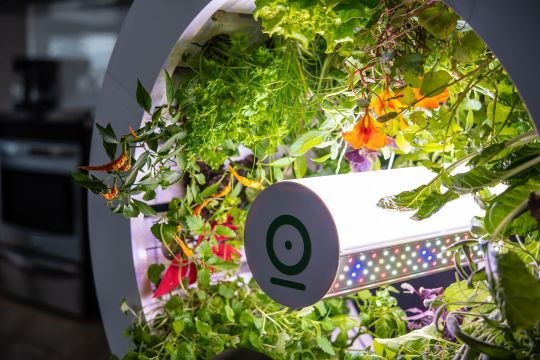
Transform your living space into a lush oasis of greenery and tranquility with a carefully designed smart indoor gardening system. Explore the key elements to consider when designing your indoor garden and discover how to create a harmonious and thriving environment for your plants.
Choosing the Right System: Selecting the perfect Smart Indoor Gardening System is the first step in creating your oasis. Consider factors such as size, style, and functionality to find a system that fits seamlessly into your home.
Whether you opt for a countertop herb garden, a vertical hydroponic setup, or a fully automated indoor greenhouse, choose a system that suits your space and gardening preferences.
Selecting Plants and Layout
Once you've chosen your system, it's time to select the plants that will inhabit your indoor garden. Consider factors such as light requirements, growth habits, and aesthetic appeal when choosing your greenery.
Experiment with different plant combinations and layouts to create visual interest and balance in your indoor garden, incorporating a mix of herbs, vegetables, and ornamental plants to suit your tastes.
Optimizing Light and Environmental Conditions
Light is essential for plant growth, so it's important to ensure that your indoor garden receives adequate illumination. Assess the natural light conditions in your home and supplement as needed with artificial lighting.
Position your indoor garden near windows or under grow lights to provide your plants with the optimal amount of light for healthy growth, and monitor environmental conditions such as temperature and humidity to create a comfortable and conducive environment.
Customizing Your System
Personalize your smart indoor gardening system to reflect your unique style and preferences. Add decorative elements such as planters, trellises, and decorative accents to enhance the visual appeal of your indoor garden.
Incorporate smart features such as automated watering systems, nutrient monitors, and remote control capabilities to streamline maintenance and ensure the health and vitality of your plants.
Creating a Maintenance Routine
Regular maintenance is key to keeping your indoor garden thriving. Develop a maintenance routine that includes tasks such as watering, pruning, and fertilizing to keep your plants healthy and happy.
Set reminders or schedule automated tasks to stay on top of maintenance chores, and take time to observe and interact with your plants to monitor their progress and address any issues that arise.
Designing your smart indoor gardening system is an opportunity to create a personalized oasis that brings beauty, tranquility, and vitality into your home. By carefully selecting plants, optimizing environmental conditions, and customizing your system to suit your style and preferences, you can create an indoor garden that nourishes the body, mind, and soul.
Get More Insights On This Topic: Smart Indoor Gardening System
#Smart Indoor Gardening System#Indoor Agriculture#Home Gardening Tech#Urban Farming#Automated Plant Care#Hydroponics#Indoor Herb Garden#Smart Home Devices#Sustainable Living
0 notes
Text
Essential Gardening Tools for Beginners: A Comprehensive Guide to Kickstart Your Garden

Get Ready To Kickstart Your Garden.
To begin with, embarking on a journey into the world of gardening can be a rewarding and fulfilling experience, especially for adult beginners. Whether you're cultivating a small balcony garden or transforming your backyard into a green oasis, having the right gardening tools is crucial. In this comprehensive guide, we'll explore the essential tools every novice gardener should consider to ensure a successful and enjoyable gardening journey.
Hand Trowel and Transplanting Spade:
To kickstart your gardening venture, invest in a quality hand trowel and transplanting spade. These versatile tools are perfect for planting small flowers, herbs, and vegetables. The hand trowel is ideal for digging small holes, while the transplanting spade is designed for moving plants without causing damage to their roots. Look for sturdy, ergonomically designed tools that provide comfort during prolonged use.
Pruners or Secateurs:
Pruners, also known as secateurs, are essential for maintaining the health and appearance of your plants. These handheld cutting tools are perfect for trimming branches, deadheading flowers, and shaping shrubs. Choose a pair with sharp blades, a comfortable grip, and a safety lock feature to prevent accidents when not in use.
Garden Gloves:
Protect your hands from dirt, thorns, and other potential hazards with a reliable pair of garden gloves. Opt for gloves made from durable materials that offer both flexibility and protection. Whether you're planting, weeding, or handling thorny plants, a good pair of gloves will keep your hands safe and clean.
Watering Can or Hose:
Proper watering is crucial for the success of your garden. Invest in a watering can or a hose, depending on the size of your garden. A watering can is ideal for smaller spaces and provides precise control over water distribution. If you have a larger garden, a hose with an adjustable nozzle will make watering more efficient.
Garden Fork:
A garden fork is a versatile tool that helps with tasks such as turning soil, breaking up clumps, and aerating the ground. Look for a sturdy fork with sharp tines to make your soil preparation more effective. This tool is especially useful for cultivating larger areas and preparing the soil for planting.
Rake:
Keep your garden free from debris, leaves, and weeds with a reliable garden rake. A leaf rake with flexible tines is excellent for gathering leaves and light debris, while a garden rake with sturdy tines is perfect for leveling soil and removing weeds. Look for a rake with an adjustable handle to suit your height and make the task more comfortable.
Wheelbarrow or Garden Cart:
Make transporting soil, plants, and other materials a breeze with a wheelbarrow or garden cart. These tools are essential for reducing the strain on your back and making large-scale gardening projects more manageable. Choose a wheelbarrow with a sturdy frame and durable wheels for optimal functionality.
Soil pH Tester:
Understanding your soil's pH level is crucial for successful gardening. Invest in a soil pH tester to assess whether your soil is acidic, neutral, or alkaline. This information will help you choose the right plants and adjust your soil amendments accordingly, promoting healthier and more vibrant growth.
Garden Kneeler and Seat:
Gardening often involves spending extended periods on your knees, which can be uncomfortable. A garden kneeler and seat provide a convenient solution, offering a comfortable padded surface for kneeling or a sturdy seat for taking a break. Look for a model that is foldable for easy storage.
Sun Hat and Sunscreen:
Protect yourself from the sun's harmful rays while working in the garden. A wide-brimmed sun hat and sunscreen are essential tools to ensure your safety and well-being. Choose a hat that provides ample shade for your face and neck, and opt for a broad-spectrum sunscreen with a high SPF rating.
Starting a garden can be a fulfilling and enjoyable experience, especially with the right tools by your side. Invest in quality gardening tools that suit your specific needs and make the process more efficient and enjoyable. From hand trowels to pruners, each tool plays a crucial role in nurturing your garden to its full potential. By incorporating these essential tools into your gardening routine, you'll be well on your way to creating a vibrant and thriving green space. Happy gardening!
#botany#garden#gardening#horticulture#how to#planting#plants#beginner gardening#tips and tricks#beginner guide#gardening tools#indoor herb garden#garden tools#gardening essentials#gardening tips#vegetable gardening#container gardening#pruners#watering can#watering the garden#soil ph tester#garden gloves#garden fork#garden rake#wheelbarrow
0 notes
Text
Herb Kits | Grow Your Own Fresh Herbs Indoors
Pot and Bloom offers a variety of herb kits that make it easy to grow your own fresh herbs indoors. Our kits include everything you need, from the seeds or plants to the soil and pots. We also offer a variety of herbs to choose from, so you can find the perfect ones for your cooking needs. Shop our herb kits today and start growing your own fresh herbs!
0 notes
Text
How does one start an indoor herb garden in their kitchen?
Growing herbs in your own indoor herb garden can be a fun and rewarding experience. Not only do herbs provide fresh and flavorful ingredients for cooking, but they can also improve the air quality of your home. Starting an indoor herb garden in your kitchen is a great way to bring some greenery into your living space and create a more sustainable lifestyle.
Continue reading Untitled
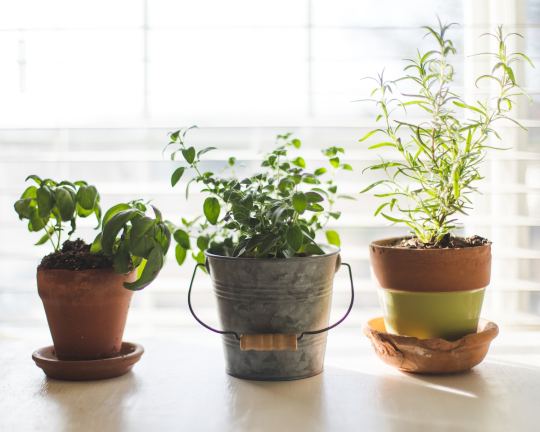
View On WordPress
#aesthetics#care#containers#cooking#flavors#herbs#indoor herb garden#kitchen#potting soil#sunlight#sustainability#therapeutic#watering
1 note
·
View note
Text
Indoor Culinary Herb Garden: 5 Types of Chives to Grow for Unique Flavors
Chives are one of the most popular culinary herbs that are used in a variety of dishes such as salads, soups, stews, and more. They are easy to grow and maintain, making them an excellent choice for indoor herb gardens. There are several varieties of chives that can be grown indoors, each with its unique flavor and appearance. In this blog post, we will discuss the different kinds of chives that…

View On WordPress
#chives#garlic chives#growing chives#herb garden#herbs#indoor herb garden#indoor herb gardening#indoor herbs#unique flavors
1 note
·
View note
Text
Bluetooth Led Lampada per Piante, Intelligente a Spettro Completo Grow Light
Bluetooth Led Lampada per Piante, Intelligente a Spettro Completo Grow Light con 27 Spettri di Crescita Delle Piante e 2 Modalità di Luce App, Collo d’oca a 360 Gradi e Rimovibile, Timer Automatico [Classe di efficienza energetica A]
Questa lampada LED è progettata per l’illuminazione “intelligente” delle piante ed è in grado di connettersi tramite Bluetooth a smartphone e tablet (sia Android…

View On WordPress
#applicazione coltivazione indoor#coltivazione indoor#coltivazione vegetali#diivoo#diy greenhouse#full spectrum#gardering#grow lights for indoor plans#inddor vegetable garden#indoor coltivazione#indoor garden#indoor herb garden#led lights#seed starting indoors
0 notes
Text

Star Wars + Moodboards
Codywan: Desert Husbands
#codywan#commander Cody#tcw commander cody#Codywan au#obi-wan kenobi#obi wan kenobi#Star Wars#sw the clone wars#star wars the clone wars#tcw#sw tcw#tcw cody#star wars moodboard#mine#I really wanted include pics of like a little kitchen and pantry area#and a little garden (&/or indoor garden) that obi wan would use the Force to grow food and herbs and tea leaves and stuff#but i couldnt find ones quite like i envisioned plus it ended up making things look too cluttered alas#oops ok fixed the link
910 notes
·
View notes
Text
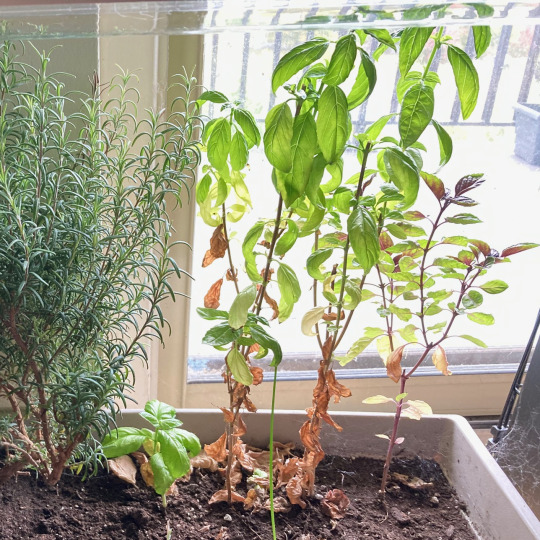
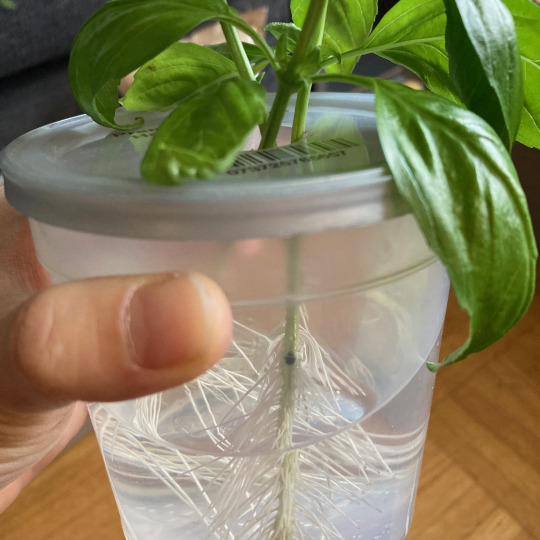


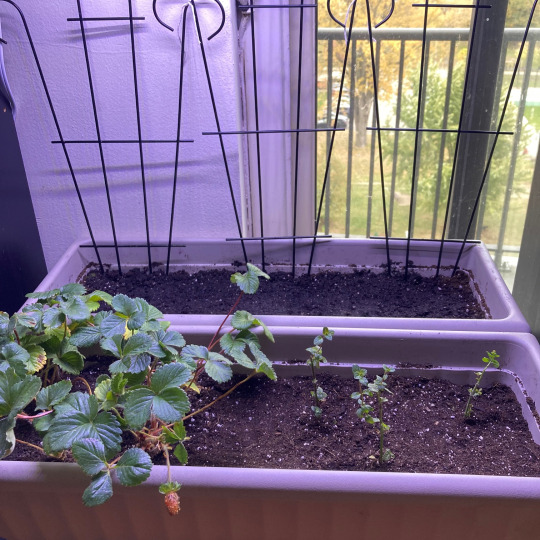
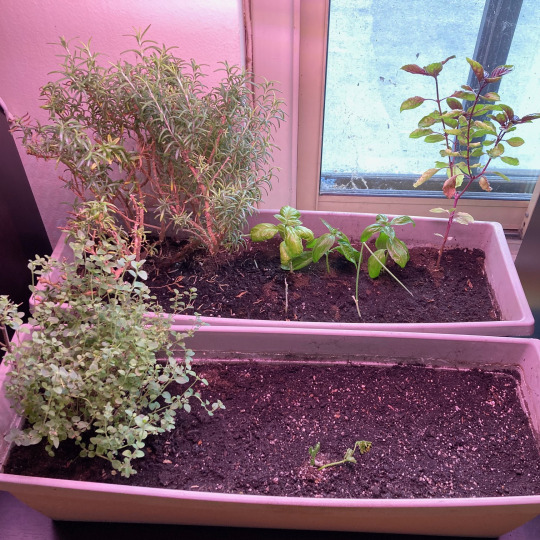

Looks like it is time to propagate the basil.
After a week or so, the basil cuttings have grown a lot of healthy roots.
I bought another IKEA Kallax shelf for the second tier of the garden, along with another set of Feit Electric LED grow lights. I used adhesive velcro strips to stick the lights to the top of the shelf, which has worked for the most part. One side of the top tier light got unstuck so I've had to secure it with string instead. We'll see how long the rest of them last.
Cat tried to supervise my gardening efforts, but then he fell asleep.
The top tier of the garden. The front planter has the strawberry plant and mint cuttings I've transplanted from the balcony. The back planter has trellises for the Sugar Ann snap peas and Tiny Tim cherry tomatoes I've seeded.
The bottom tier is the same as before, primarily herbs. The basil cuttings have been planted at the back, and the front space will be for experimenting with cilantro.
The 2-tier garden completed.
24 notes
·
View notes
Text

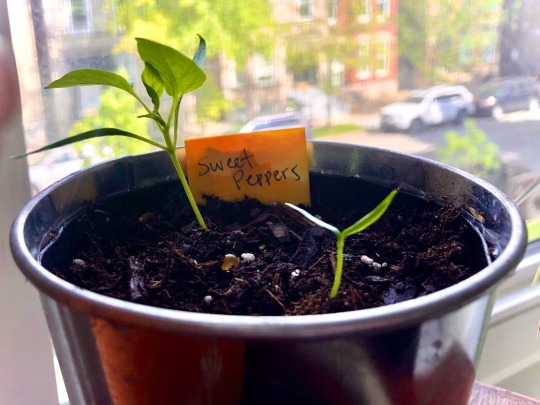
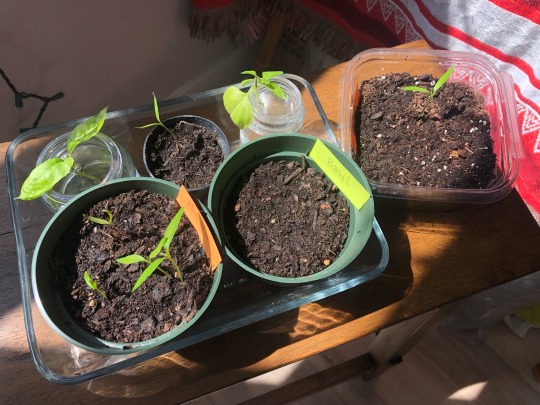
I need to get bigger pots for most of these soon, but this is my attempt at indoor gardening so far. If anyone knows how I can fix the parsleys please tell me. They seem to hate life
#I have a huge old basil plant that’s extremely leggy so I’ve been trying to propagate it as much as possible#those glass jars are weed containers I cleaned out lol#plants#herbs#peppers#indoor gardening#my photos
14 notes
·
View notes
Text


9/18/23 ~ Marigolds I didn’t even try to grow. Just seeds that fell into the compost garden from last years flowers 🌼 featuring one of my now FOUR Marshmallow Root plants 🙌🏻 I am going to try and collect seeds from the Marshmallow Root this year.
#indoor garden#container gardening#sustainable gardening#vegetable gardening#starting seeds#grow organic#grow your own food#organic gardening#tomato garden#green witch#herb garden#cooking herbs#medicinal herbs#marshmallow root#marigold#compost garden#raised beds
31 notes
·
View notes
Text

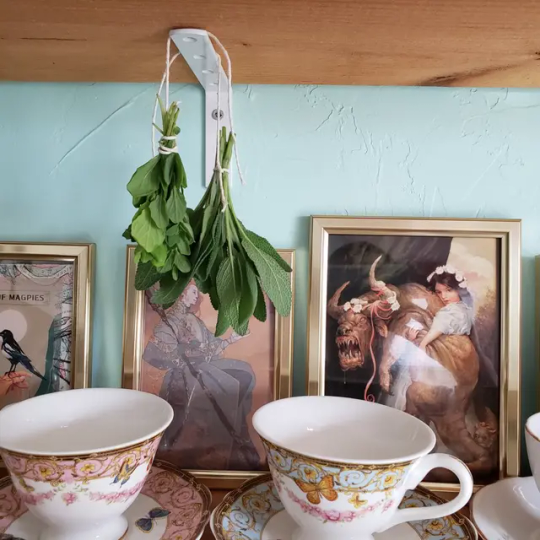
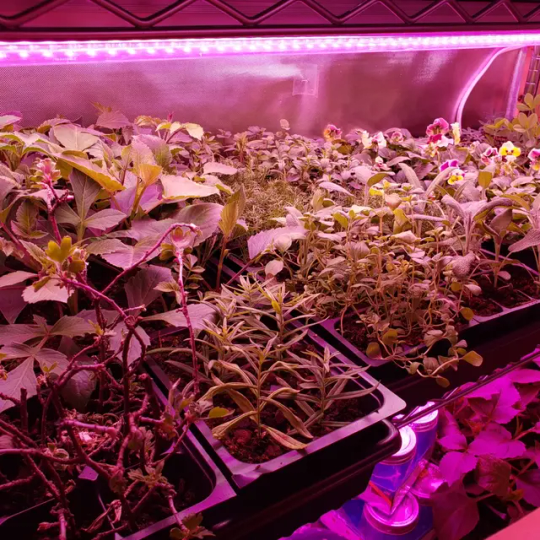

My little indoor grow setup is doing so well that I have to pinch some of the herbs today! Here's marjoram and sage.
11 notes
·
View notes
Text
A Beginner's Guide to Growing Herbs Indoors: Tips for Thriving Indoor Herb Gardens

For those who have never grown herbs before, cultivating them indoors can be a delightful and fragrant experience. Growing an indoor herb garden is a wonderful and doable hobby, regardless of your interest in cooking or just the convenience of having fresh herbs on hand. This in-depth guide will show you how to successfully grow your very own indoor herb garden..
Choosing the Right Herbs:
Start by selecting herbs that are well-suited for indoor cultivation. Popular choices include basil, mint, rosemary, thyme, and parsley. Choose herbs that share similar growing requirements to simplify maintenance.
Selecting the Right Containers:
Choosing the right containers is crucial for successful indoor herb gardening. Ensure that your pots have adequate drainage holes to prevent waterlogging. Additionally, consider the size of the pots, allowing ample space for root growth.
The Perfect Potting Mix:
Herbs thrive in well-draining soil. Create a suitable potting mix by combining regular potting soil with perlite or coarse sand to enhance drainage. This ensures that your herbs receive the right balance of water and air.
Providing Adequate Light:
Indoor herbs require plenty of sunlight to thrive. Place your herb garden near a south-facing window where they can receive at least 6-8 hours of sunlight daily. If natural light is scarce, consider supplementing with fluorescent grow lights.
Watering Wisely:
Overwatering is a common mistake in herb gardening. Allow the topsoil to dry out slightly before watering. When watering, do so thoroughly, ensuring the water reaches the roots. Always use a saucer under the pots to catch excess water and prevent water damage.
Temperature and Humidity:
Most herbs prefer temperatures between 60-70°F (15-21°C). Ensure the indoor environment remains well-ventilated, as stagnant air can lead to problems like mold. Humidity levels between 40-60% are generally suitable for herb cultivation.
Fertilizing Routine:
Herbs benefit from periodic feeding during the growing season. Use a balanced, water-soluble fertilizer every 4-6 weeks. Be cautious not to over-fertilize, as this can harm the plants.
Pruning and Harvesting:
Regular pruning encourages bushier growth and prevents herbs from becoming leggy, or similarly, elongated or stretched. Harvest leaves in the morning when the essential oils are most concentrated. Avoid removing more than one-third of the plant at a time to ensure continued growth.
Dealing with Common Pests:
Keep an eye out for common pests like aphids and spider mites. A mild solution of water and dish soap can help control these pests. Alternatively, introduce beneficial insects like ladybugs to keep your indoor garden pest-free.
In closing, embarking on the journey of growing herbs indoors is a delightful adventure for beginners. By choosing the right herbs, containers, soil, and providing the optimal growing conditions, you'll soon be enjoying the bountiful harvest of your indoor herb garden. Follow these tips, stay patient, and watch as your herbs flourish, bringing a touch of freshness to your culinary endeavors. Happy herb gardening!
#botany#garden#gardening#horticulture#how to#life hacks#planting#plants#tips and tricks#Indoor Herb Garden#Culinary Herbs#growing herbs#home gardening#container gardening#gardening tips#seeds#vegetable gardening#urban gardening#Beginner Gardening#organic herbs#Sustainable Gardening#Kitchen Herb Garden#Herb Planting#herbalism#Herb Care#Gardening Tips#indoor plants#house plants#potted plants#DIY Herb Garden
1 note
·
View note
Text
Easy to Grow Herbs (Indoors!)
If you’re interested in growing your own herbs for your witchy and culinary pursuits, this is a list of plants I’d recommend for getting started!
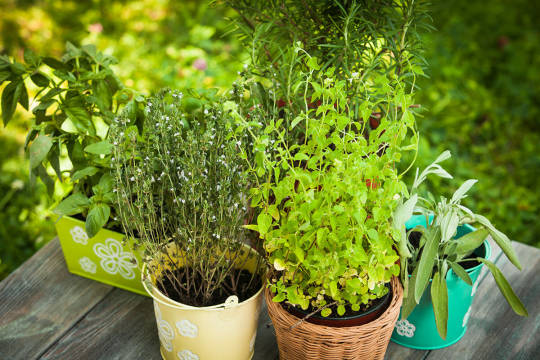
Chives
Chives, chives, chives chives chives! In the same family as onions, chives have an excellent tolerance for low-light environments (but still thrive in sunny windows). This is also a relatively low-maintenance plant, needing some consistent watering and that’s about it! Chives also tend to grow to maturity very quickly (within ~60 days of sprouting) and a simple trim down to the base is all you need to harvest.
Parsley
This wonderful luck-bringing herb is very easy to grow in your kitchen. All this low-sunlight tolerating plant needs is for the soil to be kept lightly moist with occasional watering. Keeping it in your kitchen is great for when you need to grab a couple of springs to add to your cooking!
Basil
Basil is insanely easy to grow and even easier to propagate. All you need to do is stick them in a well-drained container and keep the water moist throughout the growing cycle. Then you harvest them when they’re ready!
Thyme
This plant easily adjusts to small pots and containers. It’s also very easy to propagate from any clippings you may have! This lovely little herb is drought-tolerant and sun-loving, while also being adaptable as long as it has suitable drainage.
Rosemary
As opposed to some of the other herbs on this list, you’ll want to keep rosemary roots (and therefore the soil) on the drier side of things. Spritzing the leaves and soil will be better than soaking it in water!
#herbalism#herbs#indoor garden#kitchen witch#kitchen witch magic#hearth witch#green witch#green witch magic#witch#witchcraft#wicca#magic#pagan#paganism
33 notes
·
View notes
Text

4 notes
·
View notes
Text
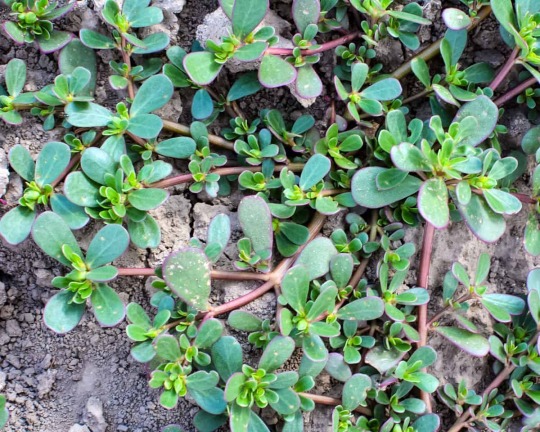


Purslane blew my mind
I noticed a small succulent looking plant growing out of one of my cactus and like any gardener does, classified it as 'other' or a weed in my specific type of plant! Untill I googled about what it could be, and found out that purslane has many vitamins, minerals and antioxidants that make it recognized as a superfood in many parts of the world. Rich in vitamin C, A, beta - carotene, omega 3 - fatty acids, calcium, folate, iron, magnesium, and potassium! Excellent for tossing into salads. It's recommended to either cook lightly, leave it raw or cook the hell of out them to avoid an okra - like gooey texture that can generally be unpleasant. The only thing I'd say to watch out for when consuming purslane is due to it's oxalate content, especially the seeds, it may not be the most suitable for those who are prone to kidney stones. And the plant that may be mistaken for it, poison spurge, will leak a white sap when broken apart!
Purslane completely changed my view on the things the grow around me, in my garden and throughout the neighborhood. It has inspired me to really consider what is a 'weed' and what is actually just an unidentified source of healing, or nourishment.
Bonus: tiny plant, big flower for some species 🌸 (photos provided by Google)
#cottageblr#plantblr#plant parent#plants#gardening#houseplants#dark cottagecore#house plants#indoor plants#weeds#medicinal plants#medicinal herbs#house plant#purslane#wild foraging#foraging#neighborhood plants#neighborhood foraging#succulent#medicinal succulent#foragecore#plant life#plant#photos from google
7 notes
·
View notes